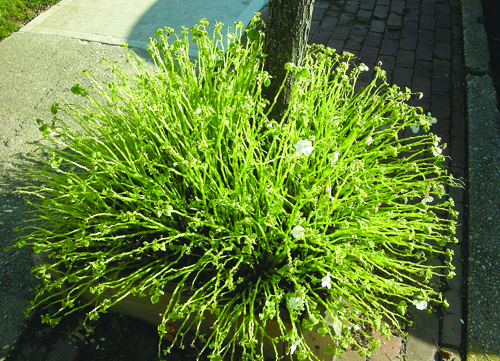Real Estate: ‘Unfathomable’ disease wreaks havoc on North Fork impatiens

In the aftermath of last August’s Tropical Storm Irene, a strange thing started happening to beds of impatiens across the North Fork. The plants’ leaves began to turn yellow, then suddenly fall off, leaving the normally colorful plants just husks of yellow-green stems.
It’s likely that most people blamed the storm for knocking out their plants. But Margery Daughtrey, a plant pathologist with the Cornell University Cooperative Extension on Sound Avenue in Riverhead, had a different suspicion.
“I noticed it and I knew it was a disease but I was hopeful that it wouldn’t come back next spring,” Ms. Daughtrey said. “But it has.”
The culprit is downy mildew, a fungus-like organism that has devastated impatiens across the country, killing off scores of the enormously popular and versatile plant.
And unfortunately, there’s no way to stop the disease, experts and businessmen said. Landscapers and homeowners alike must learn to live with this epidemic.
“Once it gets out into the landscape there just are no treatments,” Ms. Daughtrey said.
The disease, a cousin of potato late blight, spreads through spores that can infest the soil, remaining there over the winter to infect plants in the spring. The spores can also spread through the air, though plant pathologists are unsure what the range of the disease is.
The first signs of infection are small white spores that form like a powder on the underside of the leaves of impatiens. The leaves begin to yellow and, in about a month’s time, begin to fall off. Eventually, the disease finishes off the plant and the stems melt away, Ms. Daughtrey said.
“It’s hard for people to realize when they have the disease,” she said. “It doesn’t always show to them because they don’t turn their leaves over.”
Downy mildew was first seen in the 1800s in North America on native impatiens plants, a different species from the variety used in gardens and landscapes today, Ms. Daughtrey said.
The disease was spotted on impatiens in the United Kingdom in 2003, and on impatiens in Saratoga Springs, N.Y., in 2009. Downy mildew was spotted in several states last fall and, by late spring, began popping up across Long Island.
Experts are unable to explain why or how it spread so quickly, though Ms. Daughtrey believes the nature of the disease may have made transmission easier.
Since downy mildew is systemic — it infects the entire plant and not just the leaves or the stem – a cutting from an infected impatiens could spread the disease if planted, she said. Since impatiens are so popular, the plants are constantly shipped across the country to gardens and greenhouses, making it “a really difficult thing to fight.”
Fred Hammerle, owner of the Juniper Hill Incorporated wholesale greenhouses in Mattituck, said this new disease is changing the industry by endangering a plant that has been a garden mainstay for more than 30 years.
“In my lifetime, I never thought we’d see something like this happen to impatiens,” he said. “They’ve had such a good run; It’s kind of unfathomable.”
Mr. Hammerle said the landscaping industry knew about the disease and took the prescribed steps to stop it but was unable to hold the spores in check.
“It’s not one grower’s fault, it’s not one gardener’s fault,” he said. “We were treating it in this greenhouse this spring, but even our plants now are succumbing to it. It’s in the air.”
Many wholesalers have decided not to grow impatiens next year because of the widespread new disease, Mr. Hammerle said, adding that it’s important for consumers to understand why they may not see impatiens in flower beds or greenhouses next year.
Gardeners are advised not to plant impatiens if theirs are killed by the mildew, since the soil may also be infested. Infected plants should be pulled out by the roots and replaced with a different type of plant.
Plants like begonias and new guinea impatiens (which are unaffected by downy mildew) and other annuals like marigolds or petunias make good replacements for impatiens and are roughly the same price, experts said.
“We live with plant diseases all the time,” Ms. Daughtrey said. “We’ll learn how to adjust to this one eventually.”
Mr. Hammerle agreed this new disease may not be all bad news.
“The landscape is going to change,” he said. “We’re going to be driving down the streets and seeing very different plants. That could be a very good thing.”








